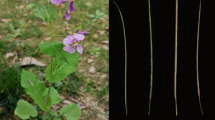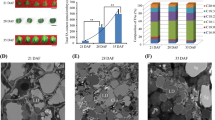Abstract
Quinoa seeds are gluten- and cholesterol-free, contain all amino acids required by the human body, have a high protein content, provide endocrine regulation, protein supplementation, and cardiovascular protection effects. However, metabolite accumulation and transcriptional regulatory networks in quinoa seed development are not well understood. Four key stages of seed development in Dianli-3260 and Dianli-557 were thus analyzed and 849 metabolites were identified, among which sugars, amino acids, and lipids were key for developmental processes, and their accumulation showed a gradual decrease. Transcriptome analysis identified 40,345 genes, of which 20,917 were differential between the M and F phases, including 8279 and 12,638 up- and down-regulated genes, respectively. Grain development processes were mainly enriched in galactose metabolism, pentose and glucuronate interconversions, the biosynthesis of amino acids, and carbon metabolism pathways, in which raffinose, phosphoenolpyruvate, series and other metabolites are significantly enriched, gene-LOC110689372, Gene-LOC110710556 and gene-LOC110714584 are significantly expressed, and these metabolites and genes play an important role in carbohydrate metabolism, lipid and Amino acid synthesis of quinoa. This study provides a theoretical basis to expand our understanding of the molecular and metabolic development of quinoa grains.
Key message
We constructed the main network pathways of metabolites and genes during the development of quinoa grains and found that sugar and amino acids are the important metabolites.








Similar content being viewed by others
Data availability
No data was used for the research described in the article.
References
Aharoni A, Galili G (2011) Metabolic engineering of the plant primary–secondary metabolism interface. Curr Opin Biotechnol 22:239–244. https://doi.org/10.1016/j.copbio.2010.11.004
Ahmed K, Khan M, Siddiqui H, Ajmat H (2020) Chitosan and its oligosaccharides, a promising option for sustainable crop production—a review. Carbohydr Polym 227:115331. https://doi.org/10.1016/j.carbpol.2019.115331
Amir R, Galili G, Cohen H (2018) The metabolic roles of free amino acids during seed development. Plant Sci 275:11–18. https://doi.org/10.1016/j.plantsci.2018.06.011
An Z, Chen Y, Zhang R, Song Y, Sun J, He J, Bai J, Dong L, Zhan Q, Abliz Z (2010) Integrated ionization approach for RRLC-MS/MS-based metabonomics: finding potential biomarkers for lung cancer. J Proteome Res 9:4071–4081. https://doi.org/10.1021/pr100265g
Blasco H, Błaszczyński J, Billaut JC, Nadal-Desbarats L, Pradat PF, Devos D, Moreau C, Andres CR, Emond P, Corcia P, Słowiński R (2015) Comparative analysis of targeted metabolomics: dominance-based rough set approach versus orthogonal partial least square-discriminant analysis. J Biomed Inform 53:291–299. https://doi.org/10.1016/j.jbi.2014.12.001
Boccard J, Rudaz S (2016) Exploring Omics data from designed experiments using analysis of variance multiblock Orthogonal Partial Least Squares. Anal Chim Acta 920:18–28. https://doi.org/10.1016/j.aca.2016.03.042
Buckeridge MS, Santos HP, Tiné M (2000) Mobilisation of storage cell wall polysaccharides in seeds. Plant Physiol Biochem 38:141–156. https://doi.org/10.1016/S0981-9428(00)00162-5
Cao Y, Liu S, Liu K, Abbasi I, Cai C, Yao J (2019) Molecular mechanisms relating to amino acid regulation of protein synthesis. Nutr Res Rev 32:183–191. https://doi.org/10.1017/S0954422419000052
Casini P (2019) Seed yield of two new quinoa (Chenopodium quinoa Willd.) breeding lines as affected by sowing date in Central Italy. Acta Agric Slov 113:51–62. https://doi.org/10.14720/AAS.2019.113.1.05
Chen W, Gong L, Guo Z, Wang W, Zhang H, Liu X, Xiong L, Yu S (2013) A novel integrated method for large-scale detection, identification, and quantification of widely targeted metabolites: application in the study of rice metabolomics. Mol Plant 6:1769–1780. https://doi.org/10.1093/mp/sst080
Eriksson L, Kettanehwold N, Wikström C, Wold S (2006) Multi- and megavariate data analysis: Part I: basic principles and applications, vol 8. Umetrics Inc, San Jose, pp 263–336. https://doi.org/10.1201/b14117-9
Escuredo O, Martin GIM, Moncada GW, Fischer S, Hierro JMH (2014) Amino acid profile of the quinoa (Chenopodium quinoa Willd.) using near infrared spectroscopy and chemometric techniques. J Cereal Sci 60:67–74. https://doi.org/10.1016/j.jcs.2014.01.016
Forde BG, Lea PJ (2017) Glutamate in plants: metabolism, regulation, and signalling. J Exp Bot 58:2339–2358. https://doi.org/10.1093/jxb/erm121
Fraga C, Clowers C, Ronald J (2010) Moore and Erika M. Zink. Signature-discovery approach for sample matching of a nerve-agent precursor using liquid chromatography–mass spectrometry, XCMS, and chemometrics. Anal Chem 82:4165–4173. https://doi.org/10.1021/ac1003568
Gómez-Ramírez A, López-Santos C, Cantos M, García JL, Molina R, Cotrino J, Espinós JP, González-Elipe AR (2017) Surface chemistry and germination improvement of Quinoa seeds subjected to plasma activation. Sci Rep 7:5924. https://doi.org/10.1038/s41598-017-06164-5
Guo J, Gu X, Lu W, Dalei L (2021) Multiomics analysis of kernel development in response to short-term heat stress at the grain formation stage in waxy maize. J Exp Bot 72:6291–6304. https://doi.org/10.1093/jxb/erab286
Horbowicz M, Obendorf RL (1994) Seed desiccation tolerance and storability: dependence on flatulence-producing oligosaccharides and cyclitols—review and survey. Seed Sci Res 4:385–405. https://doi.org/10.1017/S0960258500002440
Hu C, Tohge T, Chan SA, Song Y, Rao J, Cui B, Lin H, Wang L, Fernie AR, Zhang D (2016) Identification of conserved and diverse metabolic shifts during rice grain development. Sci Rep 6:20942. https://doi.org/10.1038/srep20942
Huang M, Zhang H, Zhao C, Chen G, Zou Y (2019) Amino acid content in rice grains is affected by high temperature during the early grain-filling period. Sci Rep 9:2700. https://doi.org/10.1038/s41598-019-38883-2
Jacobsen SE, Mujica A, Jensen CR (2003) The resistance of Quinoa (Chenopodium quinoa Willd.) to adverse abiotic factors. Food Rev Int 19:99–109. https://doi.org/10.1081/FRI-120018872
Jain C, Khatana S, Vijayvergia R (2019) Bioactivity of secondary metabolites of various plants: a review. Int J Pharm Sci Res 10:494. https://doi.org/10.13040/IJPSR.0975-8232.10(2).494-04
Kermode AR, Bewley JD, Dasgupta J, Misra S (1986) The transition from seed development to germination: a key role for desiccation? HortScience 21:1113–1118. https://doi.org/10.1016/0304-4238(86)90091-9
Komala NT, Gurumurthy R, Surendra P (2017) OMICS technologies towards seed quality improvement. Int J Pure Appl Biosci 5:1075–1085. https://doi.org/10.18782/2320-7051.3072
Koster KL, Leopold AC (1988) Sugars and desiccation tolerance in seeds. Plant Physiol 88:829–832. https://doi.org/10.1104/pp.88.3.829
Koziol MJ (1992) Chemical composition and nutritional evaluation of quinoa (Chenopodium quinoa Willd). J Food Compos Anal 5:35–68. https://doi.org/10.1016/0889-1575(92)90006-6
Kozlowski TT, Gunn CR (1972) Importance and characteristics of seeds. Seed Biol 1:1–20. https://doi.org/10.1016/B978-0-12-424301-9.50007-3
Lahuta LB, Dzik T (2011) d-chiro-Inositol affects accumulation of raffinose family oligosaccharides in developing embryos of Pisum sativum. J Plant Physiol 168:352–358. https://doi.org/10.1016/j.jplph.2010.07.027
Lahuta LB, Pluskota WE, Stelmaszewska J, Szablińska S (2014) Dehydration induces expression of GALACTINOL SYNTHASE and RAFFINOSE SYNTHASE in seedlings of pea (Pisum sativum L.). J Plant Physiol 171:1306–1314
Li T, Zhang Y, Wang D, Liu Y, Dirk L, Goodman J, Downie AB, Wang J, Wang G, Zhao T (2017) Regulation of seed vigor by manipulation of raffinose family oligosaccharides in maize and Arabidopsis thaliana. Mol Plant 10:1540–1555. https://doi.org/10.1016/j.molp.2017.10.014
Livak KJ, Schmittgen TD (2001) Analysis of relative gene expression data using real-time quantitative PCR and the 2−ΔΔCT Method. Methods 25:402–408. https://doi.org/10.1006/meth.2001.1262
Martins C, Fernandes D, Guimarães V, Du D, Silva D, Almeida A, Otoni W, Gmitter F, Costa M (2022) Comprehensive analysis of the GALACTINOL SYNTHASE (GolS) gene family in citrus and the function of CsGolS6 in stress tolerance. PLoS ONE 17:e0274791. https://doi.org/10.1371/journal.pone.0274791
Max B, Daniel E, Miyako K, Thomas M, Johan T (2007) Data integration in plant biology: the O2PLS method for combined modeling of transcript and metabolite data. Plant J 52:1181–1191. https://doi.org/10.1111/j.1365-313x.2007.03293.x
Morales AJ, Bajgain P, Garver Z, Maughan PJ, Udall JA (2011) Physiological responses of Chenopodium quinoa to salt stress. Int J Plant Physiol Biochem 3:219–232. https://doi.org/10.5897/IJPPB11.026
Nimbalkar MS, Pawar NV, Pai SR, Dixit GB (2020) Synchronized variations in levels of essential amino acids during germination in grain Amaranth. Braz J Bot 43:481–491. https://doi.org/10.1007/s40415-020-00624-5
Nishizawa A, Yabuta Y, Shigeoka S (2008) Galactinol and raffinose constitute a novel function to protect plants from oxidative damage. Plant Physiol 147:1251–1263. https://doi.org/10.1104/pp.108.122465
Ogata H, Goto S, Sato K, Fujibuchi W, Bono H, Kanehisa M (1999) KEGG: Kyoto encyclopedia of genes and genomes. Nucleic Acids Res 27:29–34. https://doi.org/10.1093/nar/27.1.29
Pako P, Sajewicz M, Gorinstein S, Zachwieja AZ (2008) Analysis of selected phenolic acids and flavonoids in Amaranthus cruentus and Chenopodium quinoa seeds and sprouts by HPLC. Acta Chromatogr 20420411:661–672. https://doi.org/10.1556/AChrom.20.2008.4.11
Pereira L, Buitink J, Lalanne D, Rossiet R, Pelletier S, Silva E, Leprince O (2017) Molecular characterization of the acquisition of longevity during seed maturation in soybean. PLoS ONE 12:e0180282. https://doi.org/10.1371/journal.pone.0180282
Pereira E, Encina-Zelada C, Barros L, Gonzales-Barron U, Cadavez V, Ferreira I (2018) Chemical and nutritional characterization of Chenopodium quinoa Willd (quinoa) grains: a good alternative to nutritious food. Food Chem 280:110–114. https://doi.org/10.1016/j.foodchem.2018.12.068
Peterbauer T, Richter A (2001) Biochemistry and physiology of raffinose family oligosaccharides and galactosyl cyclitols in seeds. Seed Sci Res 11:185–197. https://doi.org/10.1079/SSR200175
Peterbauer T, Lahuta LB, Blochl A, Mucha J, Jones DA, Hedley CL, Gorecki R, Richter A (2001) Analysis of the raffinose family oligosaccharide pathway in pea seeds with contrasting carbohydrate composition. Plant Physiol 127:1764–1772. https://doi.org/10.1104/pp.010534
Repo-Carrasco R, Espinoza C, Jacobsen SE (2003) Nutritional value and use of the Andean crops Quinoa (Chenopodium quinoa) and Kaiwa (Chenopodium pallidicaule). Food Rev Int 19:179–189. https://doi.org/10.1081/FRI-120018884
Robert HS (2019) Molecular Communication for coordinated seed and fruit development: what can we learn from auxin and sugars. Int J Mol Sci 20:936. https://doi.org/10.3390/ijms20040936
Saravitz DM, Pharr DM, Carter TE (1987) Galactinol synthase activity and soluble sugars in developing seeds of four soybean genotypes. Plant Physiol 83:185–189. https://doi.org/10.1104/pp.83.1.185
Vega-Gálvez A, Miranda M, Vergara J, Uribe E, Puente LE, Martínez A (2010) Nutrition facts and functional potential of quinoa (Chenopodium quinoa Willd.), an ancient Andean grain: a review. J Sci Food Agric 90:2541–2547. https://doi.org/10.1002/jsfa.4158
Wang L, Fu J, Li M, Fragner L, Weckwerth W, Yang P (2016) Metabolomic and proteomic profiles reveal the dynamics of primary metabolism during seed development of lotus (Nelumbo nucifera). Front Plant Sci 7:750. https://doi.org/10.3389/fpls.2016.00750
Xian L, Tian J, Long Y, Ma H, Tian M, Liu X, Yin G, Wang L (2016) Metabolomics and transcriptomics analyses provide new insights into the nutritional quality during the endosperm development of different ploidy rice. Front Plant Sci 14:1210134. https://doi.org/10.3389/fpls.2023.1210134
Yi C, Zhi W, Chong W, Hong L, Dao H, De Z, Lei Z, Yang P, Rong G, Shao Z (2022) Comparisons of metabolic profiles for carbohydrates, amino acids, lipids, fragrance and flavones during grain development in Indica rice cultivars. Rice Sci 29:155–165. https://doi.org/10.1016/j.rsci.2022.01.004
Zhang Y, Deng T, Sun L, Landis JB, Moore MJ, Wang H, Wang H, Hao X, Chen J, Li S, Xu M, Puno PT, Raven PH, Sun H (2020) Phylogenetic patterns suggest frequent multiple origins of secondary metabolites across the seed-plant “tree of life.” Natl Sci Rev 8:nwaa105. https://doi.org/10.1093/nsr/nwaa105
Zhang S, Ghatak A, Bazargani M, Bajaj P, Varshney R, Chaturvedi P, Jiang D, Weckwerth W (2021) Spatial distribution of proteins and metabolites in developing wheat grain and their differential regulatory response during the grain filling process. Plant J 107:669–687. https://doi.org/10.1111/tpj.15410
Zhang S, Sun F, Zhang C, Zhang M, Wang W, Zhang C, Ya X (2022) Anthocyanin biosynthesis and a regulatory network of different-colored wheat grains revealed by multiomics analysis. J Agric Food Chem 70:887–900. https://doi.org/10.1021/acs.jafc.1c05029
Acknowledgements
We gratefully acknowledge the financial support of the Yunnan Expert Workstation and Shanghai “Science and Technology Innovation Action Plan” Domestic S&T Cooperation Project. We would like to thank Wuhan MetWare Biotechnology Co., Ltd. (www.metware.cn) for metabolome and transcriptome analyses.
Funding
This work was supported by the Yunnan Expert Workstation (202205AF150001). And Shanghai “Science and Technology Innovation Action Plan” Domestic S&T Cooperation Project (22015810100).
Author information
Authors and Affiliations
Contributions
QW: Conceptualization, Methodology, Formal analysis, Investigation, Writing—original draft. JS: Supervision, Investigation. JL: Resources, Supervision. PZ: Investigation, Validation. LL: Investigation, Validation. HX: Investigation, Validation. HL: Supervision. HW: Methodology. CL: Methodology, Writing—review and editing. PQ: Methodology, Writing—review and editing, Funding acquisition.
Corresponding author
Ethics declarations
Conflict of interest
The authors declare that they have no known competing financial interests or personal relationships that could have appeared to influence the work reported in this paper.
Additional information
Publisher's Note
Springer Nature remains neutral with regard to jurisdictional claims in published maps and institutional affiliations.
Supplementary Information
Below is the link to the electronic supplementary material.
Rights and permissions
Springer Nature or its licensor (e.g. a society or other partner) holds exclusive rights to this article under a publishing agreement with the author(s) or other rightsholder(s); author self-archiving of the accepted manuscript version of this article is solely governed by the terms of such publishing agreement and applicable law.
About this article
Cite this article
Wang, Q., Shi, J., Liu, J. et al. Integration of transcriptome and metabolome reveals the accumulation of related metabolites and gene regulation networks during quinoa seed development. Plant Mol Biol 114, 10 (2024). https://doi.org/10.1007/s11103-023-01402-z
Received:
Accepted:
Published:
DOI: https://doi.org/10.1007/s11103-023-01402-z




